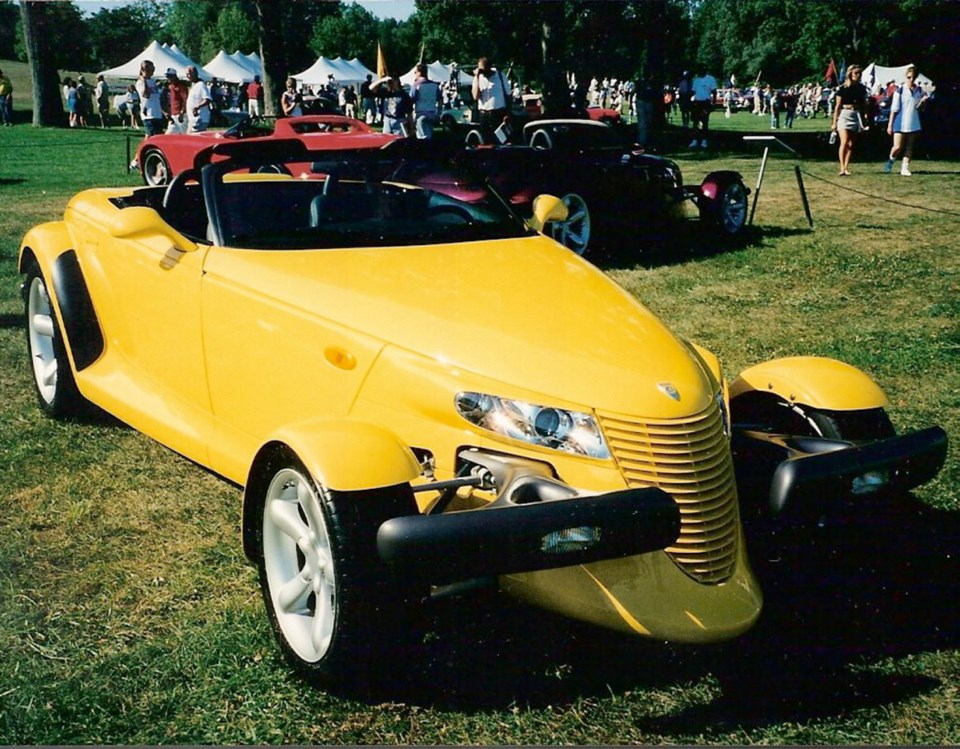Although Plymouth broke out of its conservative mode a few times with such models as the 1956-58 Fury, 1960s Barracuda, Road Runner muscle car and audacious NASCAR-inspired, high-winged Superbird of the early 1970s, Plymouth’s reputation was built mostly on sensible conservative transportation.
That’s why it was a surprise when it brought forth the Prowler, a modern reincarnation of the classic 1932 Ford rod with open wheels and a nose-down, hound-on-the-scent profile.
The Plymouth brand was produced by the Chrysler Corp. (now Fiat Chrysler Automobiles) from 1928 to 2001. It was always a proud member of the corporate family, but usually showed its pride in a subdued way, being known more for solid, reliable transportation than flamboyant ostentation.
But while Dodge was cultivated as Chrysler’s performance division, here was demure Plymouth with its Prowler, daring to outshine Dodge, not to say such retro-inspired models as the soon-to-return Ford Thunderbird.
To test the waters, Chrysler showed the Plymouth Prowler in concept form at the 1993 Detroit Auto Show, hinting that it could be put into production in three to four years. Overwhelmingly favourable media and public response convinced them to go ahead.
When the production Prowler appeared in 1997, it was remarkably close to the show car. For practical reasons, the flush headlamps were no longer narrow slits, but were now bulges on the side of the slightly longer hood. The body was also wider and the bumpers sturdier, but all in all it was kept pretty faithful to the concept.
To keep costs down, the engineers dipped generously into the company parts bin. Power came from the corporate 3.5-litre, 214-horsepower, single-overhead-cam V-6 used in the Chrysler LH cars (Chrysler LHS, Dodge Intrepid et al.). It was kept stock except that the Prowler’s narrow hood required replacing the cast-iron exhaust manifolds with stainless-steel headers.
Power went to the rear wheels via an aluminum driveshaft and a rear-mounted transaxle unit. The transmission was Chrysler’s four-speed manumatic “AutoStick,” modified for rear-wheel application.
Suspension was four-wheel independent, at the rear by coil springs and control arms and in front by coils and A-arms. The front coil/shock absorber units were mounted under the hood race-car style and actuated by lever arms, keeping them out of sight and out of the breeze for better aerodynamics.
The exposed front wheels had small cycle-type fenders attached to the suspension so that their movement followed the wheels.
The Prowler was strictly a two-seater, and its manually operated fabric top folded out of sight under the rear-hinged trunk lid. “Trunk” was somewhat of a misnomer, because the Prowler was so tautly drawn there was room for little more than the 45-litre fuel tank and a soft garment bag.
There wasn’t even room for a spare tire, so the Prowler got run-flat tires, complete with air-pressure monitors. For those who wanted to take things with them, Chrysler offered an accessory trailer whose shape mimicked the rear of the Prowler.
In authentic hotrod style, the gauges were deployed across the instrument panel, with one exception. As a real retro reminder, the tachometer was mounted separately on the steering column just like aftermarket tachs in the original hot rods.
Weight was kept to just over 1,270 kilograms through extensive use of light metals. Doors, hood, decklid and parts of the frame and suspension were aluminum, and the instrument cowl was magnesium. Because of the difficulty in welding aluminum, extensive use was made of bonding and riveting during Prowler assembly.
The Prowler was no slouch in performance. Car and Driver tested an early production model and reported zero to 100 km/h in 7.0 seconds. Top speed, however, was limited to 188 km/h by the Prowler’s brick-like 0.49 aerodynamic drag coefficient.
The Prowler was introduced as a 1997 model. There were no 1998s, but it came back for 1999 powered by an aluminum version of the V-6, now up to 250 horsepower. In what would be the last year for the Plymouth brand, 2001, it was down to just one model: the Prowler. When Plymouth disappeared, the Prowler carried into 2002 as the Chrysler Prowler. This was its last production year.
The Prowler was an interesting throwback to hot rods of the past, but one with convenience, technology and safety features that weren’t even imagined when the quintessential 1930s Ford flathead V-8 hot rods were built.
It’s highly doubtful that Chrysler made any money on the Prowler; it was strictly an image car intended to bolster Plymouth’s fading fortunes. Alas, this was too much to ask, and Plymouth joined the hundreds of other automotive nameplates that disappeared over the years. But for a demure family member, it went out with an uncharacteristic flourish.



